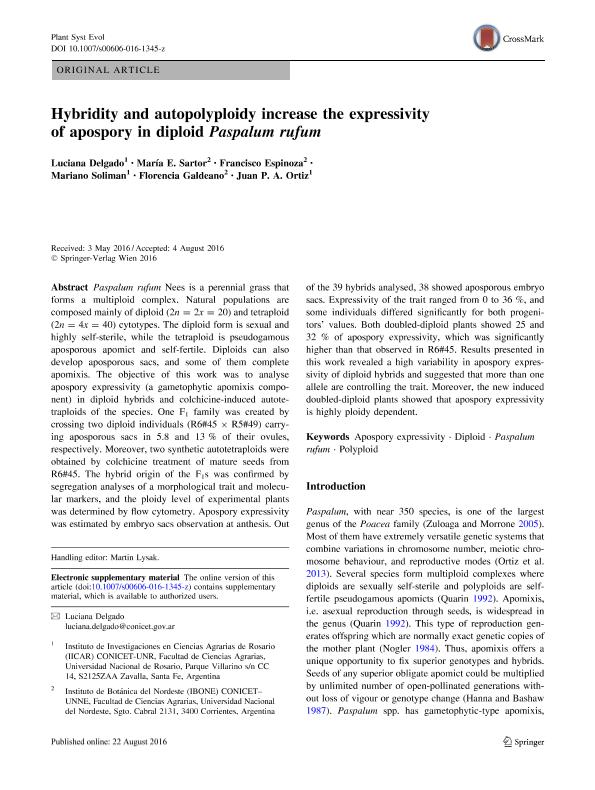Artículo
Hybridity and autopolyploidy increase the expressivity of apospory in diploid Paspalum rufum
Delgado, Luciana; Sartor, Maria Esperanza ; Espinoza, Francisco
; Espinoza, Francisco ; Soliman, Mariano
; Soliman, Mariano ; Galdeano, Florencia
; Galdeano, Florencia ; Ortiz, Juan Pablo Amelio
; Ortiz, Juan Pablo Amelio
 ; Espinoza, Francisco
; Espinoza, Francisco ; Soliman, Mariano
; Soliman, Mariano ; Galdeano, Florencia
; Galdeano, Florencia ; Ortiz, Juan Pablo Amelio
; Ortiz, Juan Pablo Amelio
Fecha de publicación:
08/2016
Editorial:
Springer Wien
Revista:
Plant Systematics and Evolution
ISSN:
0378-2697
e-ISSN:
2199-6881
Idioma:
Inglés
Tipo de recurso:
Artículo publicado
Clasificación temática:
Resumen
Paspalum rufum Nees is a perennial grass that forms a multiploid complex. natural populations are composed mainly of diploid (2n = 2x = 20) and tetraploid(2n = 4x = 40) cytotypes. The diploid form is sexual and highly self-sterile, while the tetraploid is pseudogamous aposporous apomict and self-fertile. Diploids can also develop aposporous sacs, and some of them complete apomixis. The objective of this work was to analyse apospory expressivity (a gametophytic apomixis component) in diploid hybrids and colchicine-induced autotetraploids of the species. One F1 family was created by crossing two diploid individuals (R6#45 9 R5#49) carrying aposporous sacs in 5.8 and 13 % of their ovules, respectively. Moreover, two synthetic autotetraploids were obtained by colchicine treatment of mature seeds from R6#45. The hybrid origin of the F1s was confirmed by segregation analyses of a morphological trait and molecular markers, and the ploidy level of experimental plants was determined by flow cytometry. Apospory expressivity was estimated by embryo sacs observation at anthesis. Out of the 39 hybrids analysed, 38 showed aposporous embryo sacs. Expressivity of the trait ranged from 0 to 36 %, and some individuals differed significantly for both progenitors? values. Both doubled-diploid plants showed 25 and 32 % of apospory expressivity, which was significantly higher than that observed in R6#45. Results presented in this work revealed a high variability in apospory expressivity of diploid hybrids and suggested that more than one allele are controlling the trait. Moreover, the new induced doubled-diploid plants showed that apospory expressivity is highly ploidy dependent.
Palabras clave:
Apospory
,
Expresivity
,
Diploid
,
Paspalum Rufum
Archivos asociados
Licencia
Identificadores
Colecciones
Articulos(IBONE)
Articulos de INST.DE BOTANICA DEL NORDESTE (I)
Articulos de INST.DE BOTANICA DEL NORDESTE (I)
Citación
Delgado, Luciana; Sartor, Maria Esperanza; Espinoza, Francisco; Soliman, Mariano; Galdeano, Florencia; et al.; Hybridity and autopolyploidy increase the expressivity of apospory in diploid Paspalum rufum; Springer Wien; Plant Systematics and Evolution; 302; 10; 8-2016; 1-10
Compartir
Altmétricas



